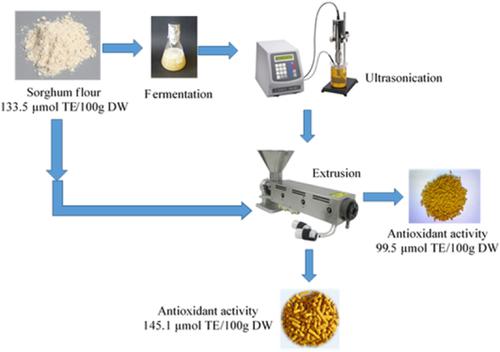当前位置:
X-MOL 学术
›
J. Food Process Eng.
›
论文详情
Our official English website, www.x-mol.net, welcomes your
feedback! (Note: you will need to create a separate account there.)
Influence of fermentation followed by ultrasonication on functional properties of sorghum extrudates
Journal of Food Process Engineering ( IF 2.7 ) Pub Date : 2020-02-16 , DOI: 10.1111/jfpe.13390 Umesh C. Lohani 1 , Kasiviswanathan Muthukumarappan 1
Journal of Food Process Engineering ( IF 2.7 ) Pub Date : 2020-02-16 , DOI: 10.1111/jfpe.13390 Umesh C. Lohani 1 , Kasiviswanathan Muthukumarappan 1
Affiliation

|
Extrusion process deals with a compromise between better texture and less nutrition. In the present study, sorghum flour was subjected to fermentation followed by ultrasonication prior to extrusion to increase the antioxidant activity (AA) and total phenolic content (TPC) in the flour. AA and TPC of the sorghum flour were increased when fermented for 12 hr and further decreased significantly with an increase in the fermentation time. During the ultrasonication, a significant diminution in AA and TPC of the flour was reported with an increment in the ultrasonication intensity and fermented flour to water ratio. No significant impact of the ultrasonication time was found on AA and TPC of the sorghum flour. Optimum AA and TPC were obtained as 178.8 μmol TE/100 g dry weight (DW) and 77.8 mg GAE/100 g DW, respectively. Extrudates obtained from the pretreated sorghum flour under optimum conditions had improved nutritional and textural qualities. Also, the pretreated sorghum flour showed low stability of starch crystallites and crystalline fraction. PRACTICAL APPLICATIONS: Millets and sorghum possess high amounts of phenolics, polyphenols, and other bioactive compounds. It was explicated from the results that the fermentation followed by the ultrasonication could improve the antioxidant activities and phenolics in the sorghum flour. Furthermore, sorghum extrudates with remarkable retention of antioxidant activity, phenolic content, functional, and textural properties were obtained. This technology may help the food industries to develop gluten‐free and healthy snacks by incorporating sorghum (underutilized cereal) into human diet.
中文翻译:

发酵后超声处理对高粱挤出物功能特性的影响
挤压工艺处理更好的质地和更少的营养之间的折衷。在本研究中,高粱粉经过发酵,然后在挤压前进行超声波处理,以提高面粉中的抗氧化活性 (AA) 和总酚含量 (TPC)。高粱粉的 AA 和 TPC 在发酵 12 小时时增加,并随着发酵时间的增加进一步显着降低。在超声波处理过程中,随着超声波处理强度和发酵面粉与水的比例的增加,面粉的 AA 和 TPC 显着降低。超声波处理时间对高粱粉的 AA 和 TPC 没有显着影响。获得的最佳 AA 和 TPC 分别为 178.8 μmol TE/100 g 干重 (DW) 和 77.8 mg GAE/100 g DW。在最佳条件下从预处理的高粱粉中获得的挤出物具有改善的营养和质地品质。此外,预处理的高粱粉显示出淀粉微晶和结晶部分的低稳定性。实际应用:小米和高粱含有大量酚类、多酚和其他生物活性化合物。结果表明,发酵后超声处理可以提高高粱粉的抗氧化活性和酚类物质。此外,获得了具有显着抗氧化活性、酚类含量、功能和质地特性的高粱挤出物。通过将高粱(未充分利用的谷物)纳入人类饮食,这项技术可以帮助食品行业开发无麸质和健康的零食。
更新日期:2020-02-16
中文翻译:

发酵后超声处理对高粱挤出物功能特性的影响
挤压工艺处理更好的质地和更少的营养之间的折衷。在本研究中,高粱粉经过发酵,然后在挤压前进行超声波处理,以提高面粉中的抗氧化活性 (AA) 和总酚含量 (TPC)。高粱粉的 AA 和 TPC 在发酵 12 小时时增加,并随着发酵时间的增加进一步显着降低。在超声波处理过程中,随着超声波处理强度和发酵面粉与水的比例的增加,面粉的 AA 和 TPC 显着降低。超声波处理时间对高粱粉的 AA 和 TPC 没有显着影响。获得的最佳 AA 和 TPC 分别为 178.8 μmol TE/100 g 干重 (DW) 和 77.8 mg GAE/100 g DW。在最佳条件下从预处理的高粱粉中获得的挤出物具有改善的营养和质地品质。此外,预处理的高粱粉显示出淀粉微晶和结晶部分的低稳定性。实际应用:小米和高粱含有大量酚类、多酚和其他生物活性化合物。结果表明,发酵后超声处理可以提高高粱粉的抗氧化活性和酚类物质。此外,获得了具有显着抗氧化活性、酚类含量、功能和质地特性的高粱挤出物。通过将高粱(未充分利用的谷物)纳入人类饮食,这项技术可以帮助食品行业开发无麸质和健康的零食。


















































 京公网安备 11010802027423号
京公网安备 11010802027423号